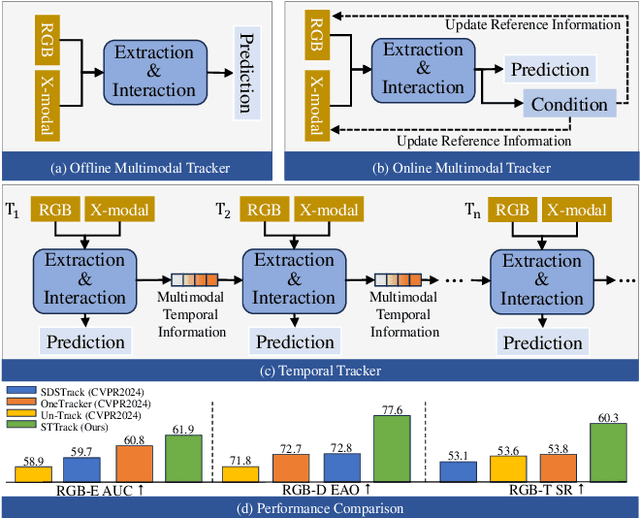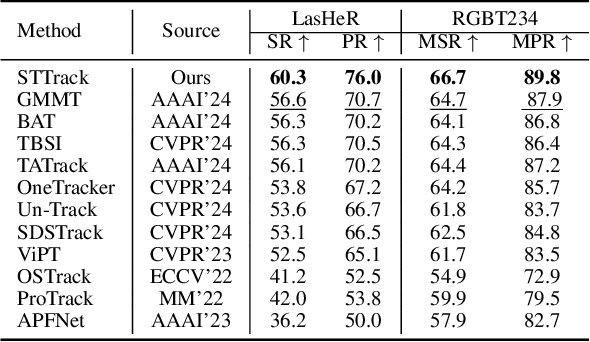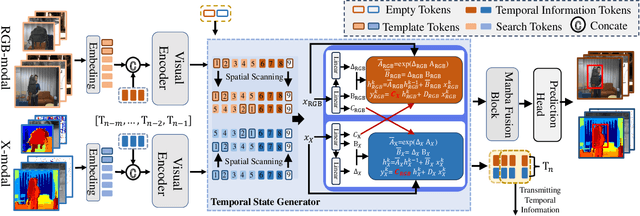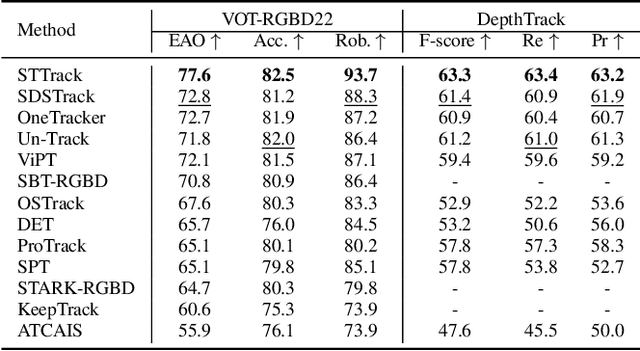Ying Tai
UltraHR-100K: Enhancing UHR Image Synthesis with A Large-Scale High-Quality Dataset
Oct 23, 2025Abstract:Ultra-high-resolution (UHR) text-to-image (T2I) generation has seen notable progress. However, two key challenges remain : 1) the absence of a large-scale high-quality UHR T2I dataset, and (2) the neglect of tailored training strategies for fine-grained detail synthesis in UHR scenarios. To tackle the first challenge, we introduce \textbf{UltraHR-100K}, a high-quality dataset of 100K UHR images with rich captions, offering diverse content and strong visual fidelity. Each image exceeds 3K resolution and is rigorously curated based on detail richness, content complexity, and aesthetic quality. To tackle the second challenge, we propose a frequency-aware post-training method that enhances fine-detail generation in T2I diffusion models. Specifically, we design (i) \textit{Detail-Oriented Timestep Sampling (DOTS)} to focus learning on detail-critical denoising steps, and (ii) \textit{Soft-Weighting Frequency Regularization (SWFR)}, which leverages Discrete Fourier Transform (DFT) to softly constrain frequency components, encouraging high-frequency detail preservation. Extensive experiments on our proposed UltraHR-eval4K benchmarks demonstrate that our approach significantly improves the fine-grained detail quality and overall fidelity of UHR image generation. The code is available at \href{https://github.com/NJU-PCALab/UltraHR-100k}{here}.
TextCrafter: Accurately Rendering Multiple Texts in Complex Visual Scenes
Apr 01, 2025Abstract:This paper explores the task of Complex Visual Text Generation (CVTG), which centers on generating intricate textual content distributed across diverse regions within visual images. In CVTG, image generation models often rendering distorted and blurred visual text or missing some visual text. To tackle these challenges, we propose TextCrafter, a novel multi-visual text rendering method. TextCrafter employs a progressive strategy to decompose complex visual text into distinct components while ensuring robust alignment between textual content and its visual carrier. Additionally, it incorporates a token focus enhancement mechanism to amplify the prominence of visual text during the generation process. TextCrafter effectively addresses key challenges in CVTG tasks, such as text confusion, omissions, and blurriness. Moreover, we present a new benchmark dataset, CVTG-2K, tailored to rigorously evaluate the performance of generative models on CVTG tasks. Extensive experiments demonstrate that our method surpasses state-of-the-art approaches.
From Zero to Detail: Deconstructing Ultra-High-Definition Image Restoration from Progressive Spectral Perspective
Mar 17, 2025Abstract:Ultra-high-definition (UHD) image restoration faces significant challenges due to its high resolution, complex content, and intricate details. To cope with these challenges, we analyze the restoration process in depth through a progressive spectral perspective, and deconstruct the complex UHD restoration problem into three progressive stages: zero-frequency enhancement, low-frequency restoration, and high-frequency refinement. Building on this insight, we propose a novel framework, ERR, which comprises three collaborative sub-networks: the zero-frequency enhancer (ZFE), the low-frequency restorer (LFR), and the high-frequency refiner (HFR). Specifically, the ZFE integrates global priors to learn global mapping, while the LFR restores low-frequency information, emphasizing reconstruction of coarse-grained content. Finally, the HFR employs our designed frequency-windowed kolmogorov-arnold networks (FW-KAN) to refine textures and details, producing high-quality image restoration. Our approach significantly outperforms previous UHD methods across various tasks, with extensive ablation studies validating the effectiveness of each component. The code is available at \href{https://github.com/NJU-PCALab/ERR}{here}.
Image Inversion: A Survey from GANs to Diffusion and Beyond
Feb 17, 2025Abstract:Image inversion is a fundamental task in generative models, aiming to map images back to their latent representations to enable downstream applications such as editing, restoration, and style transfer. This paper provides a comprehensive review of the latest advancements in image inversion techniques, focusing on two main paradigms: Generative Adversarial Network (GAN) inversion and diffusion model inversion. We categorize these techniques based on their optimization methods. For GAN inversion, we systematically classify existing methods into encoder-based approaches, latent optimization approaches, and hybrid approaches, analyzing their theoretical foundations, technical innovations, and practical trade-offs. For diffusion model inversion, we explore training-free strategies, fine-tuning methods, and the design of additional trainable modules, highlighting their unique advantages and limitations. Additionally, we discuss several popular downstream applications and emerging applications beyond image tasks, identifying current challenges and future research directions. By synthesizing the latest developments, this paper aims to provide researchers and practitioners with a valuable reference resource, promoting further advancements in the field of image inversion. We keep track of the latest works at https://github.com/RyanChenYN/ImageInversion
Adaptive Perception for Unified Visual Multi-modal Object Tracking
Feb 10, 2025Abstract:Recently, many multi-modal trackers prioritize RGB as the dominant modality, treating other modalities as auxiliary, and fine-tuning separately various multi-modal tasks. This imbalance in modality dependence limits the ability of methods to dynamically utilize complementary information from each modality in complex scenarios, making it challenging to fully perceive the advantages of multi-modal. As a result, a unified parameter model often underperforms in various multi-modal tracking tasks. To address this issue, we propose APTrack, a novel unified tracker designed for multi-modal adaptive perception. Unlike previous methods, APTrack explores a unified representation through an equal modeling strategy. This strategy allows the model to dynamically adapt to various modalities and tasks without requiring additional fine-tuning between different tasks. Moreover, our tracker integrates an adaptive modality interaction (AMI) module that efficiently bridges cross-modality interactions by generating learnable tokens. Experiments conducted on five diverse multi-modal datasets (RGBT234, LasHeR, VisEvent, DepthTrack, and VOT-RGBD2022) demonstrate that APTrack not only surpasses existing state-of-the-art unified multi-modal trackers but also outperforms trackers designed for specific multi-modal tasks.
STAR: Spatial-Temporal Augmentation with Text-to-Video Models for Real-World Video Super-Resolution
Jan 06, 2025Abstract:Image diffusion models have been adapted for real-world video super-resolution to tackle over-smoothing issues in GAN-based methods. However, these models struggle to maintain temporal consistency, as they are trained on static images, limiting their ability to capture temporal dynamics effectively. Integrating text-to-video (T2V) models into video super-resolution for improved temporal modeling is straightforward. However, two key challenges remain: artifacts introduced by complex degradations in real-world scenarios, and compromised fidelity due to the strong generative capacity of powerful T2V models (\textit{e.g.}, CogVideoX-5B). To enhance the spatio-temporal quality of restored videos, we introduce\textbf{~\name} (\textbf{S}patial-\textbf{T}emporal \textbf{A}ugmentation with T2V models for \textbf{R}eal-world video super-resolution), a novel approach that leverages T2V models for real-world video super-resolution, achieving realistic spatial details and robust temporal consistency. Specifically, we introduce a Local Information Enhancement Module (LIEM) before the global attention block to enrich local details and mitigate degradation artifacts. Moreover, we propose a Dynamic Frequency (DF) Loss to reinforce fidelity, guiding the model to focus on different frequency components across diffusion steps. Extensive experiments demonstrate\textbf{~\name}~outperforms state-of-the-art methods on both synthetic and real-world datasets.
EasySplat: View-Adaptive Learning makes 3D Gaussian Splatting Easy
Jan 02, 2025



Abstract:3D Gaussian Splatting (3DGS) techniques have achieved satisfactory 3D scene representation. Despite their impressive performance, they confront challenges due to the limitation of structure-from-motion (SfM) methods on acquiring accurate scene initialization, or the inefficiency of densification strategy. In this paper, we introduce a novel framework EasySplat to achieve high-quality 3DGS modeling. Instead of using SfM for scene initialization, we employ a novel method to release the power of large-scale pointmap approaches. Specifically, we propose an efficient grouping strategy based on view similarity, and use robust pointmap priors to obtain high-quality point clouds and camera poses for 3D scene initialization. After obtaining a reliable scene structure, we propose a novel densification approach that adaptively splits Gaussian primitives based on the average shape of neighboring Gaussian ellipsoids, utilizing KNN scheme. In this way, the proposed method tackles the limitation on initialization and optimization, leading to an efficient and accurate 3DGS modeling. Extensive experiments demonstrate that EasySplat outperforms the current state-of-the-art (SOTA) in handling novel view synthesis.
Guided Real Image Dehazing using YCbCr Color Space
Dec 24, 2024



Abstract:Image dehazing, particularly with learning-based methods, has gained significant attention due to its importance in real-world applications. However, relying solely on the RGB color space often fall short, frequently leaving residual haze. This arises from two main issues: the difficulty in obtaining clear textural features from hazy RGB images and the complexity of acquiring real haze/clean image pairs outside controlled environments like smoke-filled scenes. To address these issues, we first propose a novel Structure Guided Dehazing Network (SGDN) that leverages the superior structural properties of YCbCr features over RGB. It comprises two key modules: Bi-Color Guidance Bridge (BGB) and Color Enhancement Module (CEM). BGB integrates a phase integration module and an interactive attention module, utilizing the rich texture features of the YCbCr space to guide the RGB space, thereby recovering clearer features in both frequency and spatial domains. To maintain tonal consistency, CEM further enhances the color perception of RGB features by aggregating YCbCr channel information. Furthermore, for effective supervised learning, we introduce a Real-World Well-Aligned Haze (RW$^2$AH) dataset, which includes a diverse range of scenes from various geographical regions and climate conditions. Experimental results demonstrate that our method surpasses existing state-of-the-art methods across multiple real-world smoke/haze datasets. Code and Dataset: \textcolor{blue}{\url{https://github.com/fiwy0527/AAAI25_SGDN.}}
Exploiting Multimodal Spatial-temporal Patterns for Video Object Tracking
Dec 20, 2024



Abstract:Multimodal tracking has garnered widespread attention as a result of its ability to effectively address the inherent limitations of traditional RGB tracking. However, existing multimodal trackers mainly focus on the fusion and enhancement of spatial features or merely leverage the sparse temporal relationships between video frames. These approaches do not fully exploit the temporal correlations in multimodal videos, making it difficult to capture the dynamic changes and motion information of targets in complex scenarios. To alleviate this problem, we propose a unified multimodal spatial-temporal tracking approach named STTrack. In contrast to previous paradigms that solely relied on updating reference information, we introduced a temporal state generator (TSG) that continuously generates a sequence of tokens containing multimodal temporal information. These temporal information tokens are used to guide the localization of the target in the next time state, establish long-range contextual relationships between video frames, and capture the temporal trajectory of the target. Furthermore, at the spatial level, we introduced the mamba fusion and background suppression interactive (BSI) modules. These modules establish a dual-stage mechanism for coordinating information interaction and fusion between modalities. Extensive comparisons on five benchmark datasets illustrate that STTrack achieves state-of-the-art performance across various multimodal tracking scenarios. Code is available at: https://github.com/NJU-PCALab/STTrack.
StrandHead: Text to Strand-Disentangled 3D Head Avatars Using Hair Geometric Priors
Dec 16, 2024Abstract:While haircut indicates distinct personality, existing avatar generation methods fail to model practical hair due to the general or entangled representation. We propose StrandHead, a novel text to 3D head avatar generation method capable of generating disentangled 3D hair with strand representation. Without using 3D data for supervision, we demonstrate that realistic hair strands can be generated from prompts by distilling 2D generative diffusion models. To this end, we propose a series of reliable priors on shape initialization, geometric primitives, and statistical haircut features, leading to a stable optimization and text-aligned performance. Extensive experiments show that StrandHead achieves the state-of-the-art reality and diversity of generated 3D head and hair. The generated 3D hair can also be easily implemented in the Unreal Engine for physical simulation and other applications. The code will be available at https://xiaokunsun.github.io/StrandHead.github.io.
 Add to Chrome
Add to Chrome Add to Firefox
Add to Firefox Add to Edge
Add to Edge